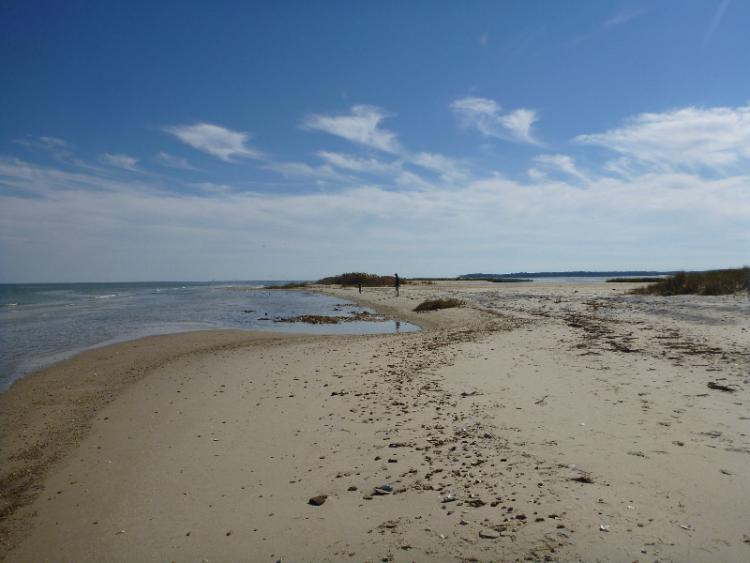Must-See Stops for Cruising Sailors Headed Southbound on the Chesapeake Bay
Sailing south for the winter? October showcases rural Chesapeake at its best. When we had the good fortune to head south, these were the gunkholes we enjoyed, and we’re happy to pass them on. Of course, there are hundreds more. Anybody else with charming gunkholes to share?

Bohemia and Sassafras Rivers
Their proximity to the C&D Canal makes them great anchorages for cruisers as they leave the canal heading south. We anchored in the Bohemia in the middle of the night and found good holding and no crab pots. After some shut-eye, we pulled up the hook and headed for the Sassafras. For years, we’d read the cruising guide about the fresh water of the Sassafras, and the ecosystem differs from what we have experienced further south in the Bay. Lily pads larger than turkey platters abound, attracting beautiful birds and bugs. Splashing the lily pads and watching the water roll across them without sinking them is delightful.
Corsica River
The passage up the Chester River winds around Eastern Neck National Wildlife Refuge before turning off into the peaceful and broad waters of the Corsica. During the week, fishermen, crabbers, and an occasional sailor wander through. At the head of the Corsica lies Centreville, with a public dinghy dock and a long history. The now shallow waters once led to an 18th century wharf where deep-water shipping was important, while the courthouse in the town square dates from 1792. Yummy milkshakes and a grocery store lie within walking distance.
Wye River
Bald eagles challenge osprey for their catch while blue herons glide gracefully, hunt stealthily, and squawk loudly, shattering the silence every time we anchor on the Wye River. Large bays such as Shaw Bay and Drum Point offer more breeze and more company from fellow boaters. Along both the Wye and Wye East, many sheltered anchorages from the popular Dividing Creek to the less frequented Big Wood Cove deliver stillness and solitude, at least until the herons cry. Shore access can be found at Drum Point and the Pickering Creek Audubon Center located on Pickering Creek.
Smith Creek
Near the mouth of the Potomac, Smith Creek offers an opportunity for quiet reflection, fishing, crabbing, dinghy exploration, or kayaking. Several coves beckoned, and when we visited last October, we had our choice of the lot. We know we picked the best one since the only other cruiser in the river anchored 500 feet from us. A public boat ramp on the creek offers convenient access to shore.
Antipoison Creek
Legend has it that Native Americans saved Captain John Smith from a near fatal encounter with the poisonous barb of a stingray, hence the name of Antipoison Creek. We found a beautiful rural setting with tall trees rising from the banks of the creek. It’s the only place we’ve seen fishermen harvesting fish from a fish trap. Until seeing these folks at work, we’d wondered whether “fish trap” was a euphemism for “trap to catch race boats in the dark.”
Gwynn’s Island
Gwynn’s Island, on the southern side of the mouth of the Piankatank River, is separated from “mainland” Virginia by a swing bridge. As non-ICW travelers, we found it novel to call for the bridge opening, which itself opened up a whole new world. We picked through a few crab pots and fish stakes on the way to the anchorage, noticing remains of some earthworks from a Revolutionary War skirmish. The royal governor of Virginia and a group of 500 Tories occupied Gwynn’s Island before being ousted by patriot militia. Once anchored, we dinghied to the southern tip of the island and found something really special: a sandy beach with a vista down the Bay that made us feel as if we were at the end of the world. Enormous oyster shells had washed up on the beach; we’ve heard arrowheads sometimes do, too. The whole place simultaneously embodied a world once inhabited with dreams of the world we were hoping to explore in the islands.
Severn River on Mobjack Bay
Since we sail out of the Severn River in Maryland, anchoring in the Severn River in Virginia gave us the opportunity to ring up friends and say, “Guess where we’re anchored? “ Plenty of water banked by ochre marshland greeted us. Several rivers and creeks empty into Mobjack Bay offering many gunkholes for cruisers seeking a quiet night at anchor. While there are marinas in the area, we found few amenities and the first and only dinghy docking fee we encountered on the Chesapeake.
For more information on these and other gunkholes to explore, check out William Shellenberger’s “Cruising the Chesapeake: A Gunkholer’s Guide” and Chesapeake Bay Magazine’s “Guide to Cruising the Chesapeake Bay.”
by: Tracy Leonard
Editor's note: This article first appeared in SpinSheet October 2014. The author's suggestions hold true in 2023!




